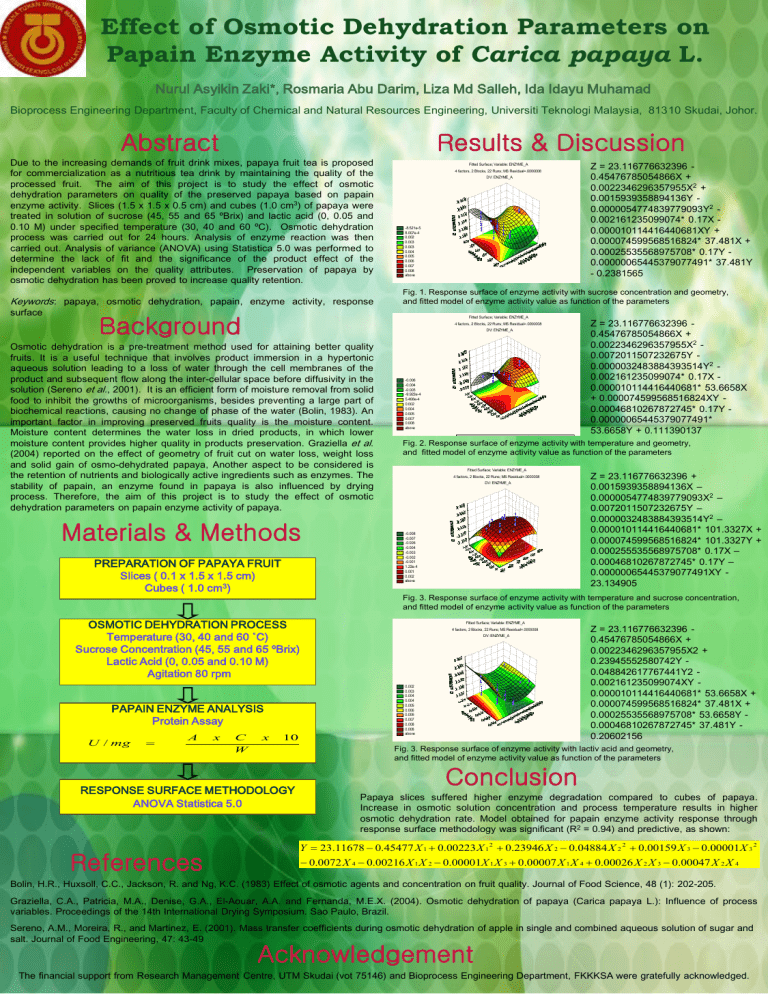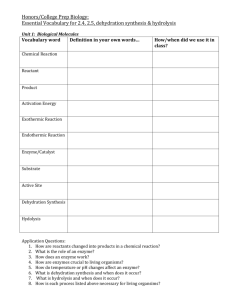posteredited

Effect of Osmotic Dehydration Parameters on
Papain Enzyme Activity of Carica papaya L.
Nurul Asyikin Zaki*, Rosmaria Abu Darim, Liza Md Salleh, Ida Idayu Muhamad
Bioprocess Engineering Department, Faculty of Chemical and Natural Resources Engineering, Universiti Teknologi Malaysia, 81310 Skudai, Johor.
Abstract
Due to the increasing demands of fruit drink mixes, papaya fruit tea is proposed for commercialization as a nutritious tea drink by maintaining the quality of the processed fruit.
The aim of this project is to study the effect of osmotic dehydration parameters on quality of the preserved papaya based on papain enzyme activity. Slices (1.5 x 1.5 x 0.5 cm) and cubes (1.0 cm 3 ) of papaya were treated in solution of sucrose (45, 55 and 65 ºBrix) and lactic acid (0, 0.05 and
0.10 M) under specified temperature (30, 40 and 60 ºC). Osmotic dehydration process was carried out for 24 hours. Analysis of enzyme reaction was then carried out. Analysis of variance (ANOVA) using Statistica 5.0 was performed to determine the lack of fit and the significance of the product effect of the independent variables on the quality attributes.
Preservation of papaya by osmotic dehydration has been proved to increase quality retention.
-8.521e-5
8.007e-4
0.002
0.003
0.003
0.004
0.005
0.006
0.007
0.008
above
Results & Discussion
Fitted Surface; Variable: ENZYME_A
4 factors, 2 Blocks, 22 Runs; MS Residual=.0000008
DV: ENZYME_A
Z = 23.116776632396 -
0.45476785054866X +
0.0022346296357955X
2 +
0.0015939358894136Y -
0.0000054774839779093Y
2 -
0.002161235099074* 0.17X -
0.000010114416440681XY +
0.000074599568516824* 37.481X +
0.00025535568975708* 0.17Y -
0.00000065445379077491* 37.481Y
- 0.2381565
Keywords : papaya, osmotic dehydration, papain, enzyme activity, response surface
Background
Osmotic dehydration is a pre-treatment method used for attaining better quality fruits. It is a useful technique that involves product immersion in a hypertonic aqueous solution leading to a loss of water through the cell membranes of the product and subsequent flow along the inter-cellular space before diffusivity in the solution (Sereno et al.
, 2001). It is an efficient form of moisture removal from solid food to inhibit the growths of microorganisms, besides preventing a large part of biochemical reactions, causing no change of phase of the water (Bolin, 1983). An important factor in improving preserved fruits quality is the moisture content.
Moisture content determines the water loss in dried products, in which lower moisture content provides higher quality in products preservation. Graziella et al
(2004) reported on the effect of geometry of fruit cut on water loss, weight loss and solid gain of osmo-dehydrated papaya, Another aspect to be considered is the retention of nutrients and biologically active ingredients such as enzymes. The stability of papain, an enzyme found in papaya is also influenced by drying process. Therefore, the aim of this project is to study the effect of osmotic dehydration parameters on papain enzyme activity of papaya.
.
Fig. 1. Response surface of enzyme activity with sucrose concentration and geometry, and fitted model of enzyme activity value as function of the parameters
Fitted Surface; Variable: ENZYME_A
4 factors, 2 Blocks, 22 Runs; MS Residual=.0000008
DV: ENZYME_A
Z = 23.116776632396 -
0.45476785054866X +
0.0022346296357955X
2 -
0.0072011507232675Y -
-0.006
-0.004
-0.003
-9.922e-4
5.468e-4
0.002
0.004
0.005
0.007
0.008
0.0000032483884393514Y
2 -
0.002161235099074* 0.17X -
0.000010114416440681* 53.6658X
+ 0.000074599568516824XY -
0.00046810267872745* 0.17Y -
0.00000065445379077491*
above 53.6658Y + 0.111390137
z=23.116776632396-.45476785054866*x+.0022346296357955*x^2
Fig. 2. Response surface of enzyme activity with temperature and geometry,
-.002161235099074*.17*x-.000010114416440681*53.6658*x and fitted model of enzyme activity value as function of the parameters
-.00000065445379077491*53.6658*y+.111390137
Materials & Methods
PREPARATION OF PAPAYA FRUIT
Slices ( 0.1 x 1.5 x 1.5 cm)
Cubes ( 1.0 cm 3 )
-0.008
-0.007
-0.006
-0.004
-0.003
-0.002
-0.001
1.22e-4
0.001
0.002
above
Fitted Surface; Variable: ENZYME_A
4 factors, 2 Blocks, 22 Runs; MS Residual=.0000008
DV: ENZYME_A
Z = 23.116776632396 +
0.0015939358894136X –
0.0000054774839779093X
2
0.0072011507232675Y –
–
0.0000032483884393514Y
2 –
0.000010114416440681* 101.3327X +
0.000074599568516824* 101.3327Y +
0.000255535568975708* 0.17X –
0.00046810267872745* 0.17Y –
0.00000065445379077491XY -
23.134905
Fig. 3. Response surface of enzyme activity with temperature and sucrose concentration, and fitted model of enzyme activity value as function of the parameters
OSMOTIC DEHYDRATION PROCESS
Temperature (30, 40 and 60 ˚C)
Sucrose Concentration (45, 55 and 65 ºBrix)
Lactic Acid (0, 0.05 and 0.10 M)
Agitation 80 rpm
PAPAIN ENZYME ANALYSIS
Protein Assay
U / mg
A x C
W x 10
RESPONSE SURFACE METHODOLOGY
ANOVA Statistica 5.0
0.002
0.003
0.004
0.004
0.005
0.006
0.006
0.007
0.008
0.008
above
Fitted Surface; Variable: ENZYME_A
4 factors, 2 Blocks, 22 Runs; MS Residual=.0000008
DV: ENZYME_A
Z = 23.116776632396 -
0.45476785054866X +
0.0022346296357955X2 +
0.23945552580742Y -
0.048842617767441Y2 -
0.002161235099074XY -
0.000010114416440681* 53.6658X +
0.000074599568516824* 37.481X +
0.00025535568975708* 53.6658Y -
0.00046810267872745* 37.481Y -
0.20602156
Fig. 3. Response surface of enzyme activity with lactiv acid and geometry, and fitted model of enzyme activity value as function of the parameters
Conclusion
Papaya slices suffered higher enzyme degradation compared to cubes of papaya.
Increase in osmotic solution concentration and process temperature results in higher osmotic dehydration rate. Model obtained for papain enzyme activity response through response surface methodology was significant (R 2 = 0.94) and predictive, as shown:
References
Y
23 .
11678
0 .
0072 X
4
0 .
45477 X
0 .
00216 X
1
X
1
2
0 .
00223 X
1
2
0 .
23946
0 .
00001 X
1
X
3
X
2
0 .
04884 X
2
2
0 .
00159 X
3
0 .
00001 X
0 .
00007 X
1
X
4
0 .
00026 X
2
X
3
0 .
00047 X
2
X
4
3
2
Bolin, H.R., Huxsoll, C.C., Jackson, R. and Ng, K.C. (1983) Effect of osmotic agents and concentration on fruit quality. Journal of Food Science, 48 (1): 202-205.
Graziella, C.A., Patricia, M.A., Denise, G.A., El-Aouar, A.A. and Fernanda, M.E.X. (2004). Osmotic dehydration of papaya (Carica papaya L.): Influence of process variables. Proceedings of the 14th International Drying Symposium. Sao Paulo, Brazil.
Sereno, A.M., Moreira, R., and Martinez, E. (2001). Mass transfer coefficients during osmotic dehydration of apple in single and combined aqueous solution of sugar and salt. Journal of Food Engineering, 47: 43-49
Acknowledgement
The financial support from Research Management Centre, UTM Skudai (vot 75146) and Bioprocess Engineering Department, FKKKSA were gratefully acknowledged.


